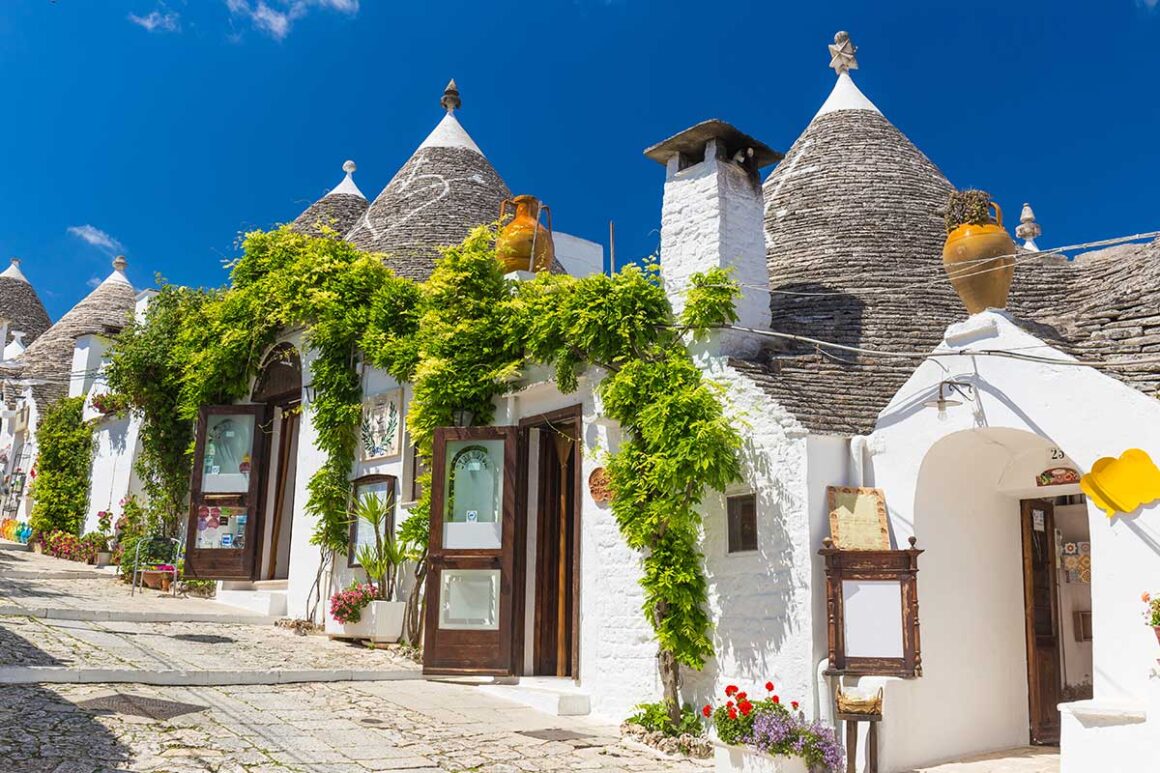Alberobello
General information: Alberobello is worldwide famous for its typical buildings and has been a Unesco World Heritage Site since 1996. The town stands on a relief, (428 m; pop. 11,040 approx.) and covers an area on the slopes of a valley generated by an old stream.
Historical notes: the origins of the name “Alberobello” can be traced back to a document dated 1272, which speaks of Sylva aut nemus “arboris belli” (Wood or Forest of the War Tree). It was not a human settlement, but a wood, and precisely an oak grove that once covered the whole area. The colonization of the Selva began in the fifteenth century on behalf of its owners: the Counts of Conversano, the nobles Acquaviva d’Aragona, who sent some people from Noci and other nearby fiefdoms to cultivate this land. The peasants were allowed to build houses, though with the express prohibition of using any type of lime; actually, the «PRAMMATICA DE BARONIBUS» law was in force at that time, and it forbade the barons to erect new urban agglomerations without the royal approval. This was the main reason for the prohibition to erect buildings by using lime, since the improvised houses, called “casedde”, were actually temporary and in the event of a royal inspection they had to be immediately demolished. Over the following decades the population grew and reached 3,500 inhabitants; the Church of SS. Medici Cosma and Damiano was enlarged and there came the first priests, the first doctors, a lawyer. The desire for freedom was asserting itself in minds; in May 1797, during a visit to Taranto, the king of Naples Ferdinand IV was implored by seven courageous villagers and signed the decree which liberated the Selva from feudal slavery, and appointed it Royal City. Thus, the Count’s oppression along with the prohibition to build houses with lime finally came to an end.
The trulli: the etymology of the word comes from the Latin turris, trulla, or from the Greek tholos, or from the Greek-Byzantine torullosa, all meaning “dome”. The trullo is a construction with a central circular or square plan, built dry, on whose perimeter is set the very thick dry-stone masonry. The load-bearing walls are completed by a pseudo-dome which forms the cover made of “chiancarelle”, limestone stones which are dry laid in concentric circles and blocked at the apex by a stone (serraglia) and by a pinnacle of various shapes; the pinnacles are in carved stone and represent the SIGNATURE of the Mastro Trullaro. On the cones you can see the symbols traced with milk of lime, linked to different traditions of magical-pagan, Christian and even primitive origin.
Historical-artistic / religious itinerary.
Let’s start from the “Aia Piccola” district: by “Aia” (barnyard) we mean a large open space which in the past was used for threshing wheat. The area includes about 400 trulli in their original state. We soon get to the “Museum of the Territory”, characterized by an agglomeration of communicating and adjoining trulli, the oldest of which date back to the 18th century. The museum houses a permanent collection on local architectural and cultural traditions. Then we get to “Casa d’Amore”, i.e. the first house built using mortar and without the classic trullo shape. It was erected immediately after the issue of the royal decree through which Alberobello was finally free from feudal vassalage; this event is remembered by an epigraph on the facade. Not to be missed, a visit to the “Sanctuary of the Physician Saints”: built in 1885 on what was the original church, it features neoclassical architecture. The façade is characterized by two bell towers erected as votive torches in honor of the two patron saints of the town: Saints Cosmas and Damian. Behind the basilica we find the “Trullo Sovrano”, the only trullo on two floors; its highest dome measures 14 meters. It is called “Sovereign” for its size and since it hosted the relics of the Physician Saints.
Let’s go back and walk along the main street, heading towards the small terrace called “Belvedere”. From here, you can admire the splendid view of the other district, called “Monti”, which is characterized by more than 1,000 trulli arranged along seven different streets. The entire Monti district is purely intended for tourist and commercial activities. At the intersection of Via Monte Nero and Via Monte Pasubio we find the Trullo Siamese, one of the oldest buildings in Alberobello. It rises on cyclopean stones and is composed of two intertwining cones. Our visit ends at the Church of Sant’Antonio: built between 1926 and 1927 on the top of the Monti district, it reproduces the features of the typical houses of the district itself. A 21-meter-high dome in the shape of a trullo is grafted onto a Greek cross plan, thus integrating perfectly with the surrounding buildings. The church underwent a complete restoration in 2004.
Where you can eat:
- La Cantina: Vico Lippolis, 9 080 4323473 Closed on Sunday evening and Tuesday.
- L’Aratro: Via monte san Michele, 25 080 4322789.
Shopping:
- Along the seven streets of the Monti district you can buy souvenirs of all kinds and taste typical products.
- The weekly market is held on Thursdays.
Events and festivals:
- Historical re-enactment of Alberobello’s liberation from feudal rule (July)
- Folk Festival (first days of August)
- Patronal Feast of Saints Cosmas and Damian (between 25th and 28th September)
- The Living Passion (Good Friday)



